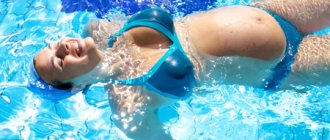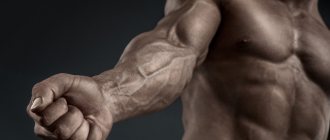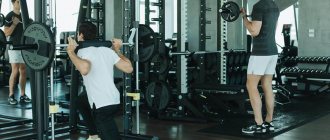Kettlebell lifting appeared in the late forties of the last century. During this time, some changes were made to the sport. Although for a long time it was considered purely male, over time women and girls joined it. Thanks to this sport, a trend like kettlebell fitness appeared, and there were even more amateurs among women.
Peculiarities
Kettlebell lifting is a cyclic sports discipline aimed at fulfilling standards with a kettlebell (one or two) for the maximum number of repetitions in a certain time; for men and women there are certain requirements and differences in the weight of the equipment. All exercises are performed standing. The International Kettlebell Lifting Union has 56 federations around the world.
In the power biathlon program for men, kettlebells weighing 16, 24 and 32 kg are used. For power juggling, women and boys from 11 years of age use 8 kg weights.
Federation
Main article: International Kettlebell Lifting Union
Main article: All-Russian Kettlebell Lifting Federation
The European Kettlebell Lifting Union (EKLU) was created in 1992 on the initiative of the Baltic states. Lithuania, Latvia, Estonia, Russia, Ukraine, and Belarus took part in its work. ESGS was the first international organization in kettlebell lifting. On October 29, 1992, the International Kettlebell Lifting Federation (IFGS) was created, which included seven countries that were former republics of the USSR. The first European Kettlebell Lifting Championship took place in 1992, the first World Championship in 1993, and the first World Cup in 1994. These two structures (USGS and MFGS) worked in parallel, according to their powers. In 2007, the MFGS was dissolved, and the ESGU was reorganized into the International Kettlebell Lifting Union (IKWS) with headquarters in Latvia.
The main Russian organization is the All-Russian Kettlebell Lifting Federation (VFGS). VFGS is a member of the International Union of Kettlebell Lifting.
The International Kettlebell Lifting Union (IUKL) has been a member of TAFISA since 2009.
Pros of kettlebell lifting
- First of all, discipline develops strength endurance.
- Repeating the standard multiple times over a certain period of time helps improve speed and coordination.
- Sport improves the quality of not only skeletal muscles, but also heart muscle.
- Blood circulation improves, vascular elasticity increases, which helps normalize blood pressure in healthy people.
- Also, multi-joint exercises of kettlebell lifting allow you to develop and maintain joint mobility, provided that the correct exercise technique is maintained.
What muscles work
In kettlebell lifting, as in many other areas, almost all muscle groups work to develop endurance and functionality of the body. The deltoid muscles, trapezius, muscles of the back, abdomen, as well as the legs and buttocks are subject to special stress.
Deep muscles also work, which can often be trained under static tension. Often stabilizer muscles work in exercises that use inertia. To lift and jerk a weight, you need the help of the buttocks, quadriceps, and abs in order to throw the projectile by inertia without special involvement of the shoulder muscles.
Kettlebell lifting rules
Disciplines for men
The compulsory program for men includes two disciplines:
- Double-event - a push of two weights and a snatch of one weight with a change of hands without a break.
- Push two weights in a long cycle with a short descent of the weights.
The kettlebell lifting program for women includes only the snatch.
Sample kettlebell training programs 5×5
Two sample 5×5 kettlebell training programs:
First option
Monday
- A-1: Kettlebell Overhead Press
- A-2: Lying Kettlebell Row
Do A-1 and A-2 in turn. In other words, do one set of A-1, rest for a minute, then do set A-2, rest for a minute, then a second set of A-1, etc. Continue alternating A-1 and A-2 until you have completed all five sets.
- B-1: Kettlebell Squats
- B-2: Kettlebell swing (two hands)
Exercises are performed in the same way as A-1 and A-2
- In conclusion - “Mill” with two weights - 2x5 (left and right hands alternately)
Take two-minute breaks between sets. Perform five reps on each side for each set.
Wednesday
- A-1: Kettlebell Floor Press
- A-2: Double Arm Kettlebell Row
The exercises are performed in the same way as described above.
- B-1: Kettlebell Squats
- B-2: Kettlebell Snatch (two hands)
The exercises are performed in the same way as described above.
- To finish - “Turkish get up” - 2x5 (with a kettlebell in the left and right hands alternately)
Take two-minute breaks between sets. For each set, perform five reps on each side.
Friday
- A-1: Kettlebell Overhead Press (Seated)
- A-2: Lying Kettlebell Row
Do A-1 and A-2 in turn. In other words, do one set of A-1, rest for a minute, then do set A-2, rest for a minute, then a second set of A-1, etc. Continue alternating A-1 and A-2 until you have completed all five sets.
- B-1: Kettlebell Squats
- B-2: Kettlebell swing (two hands)
- In conclusion - “Mill” with two weights - 2x5 (left and right hands alternately)
Take two-minute breaks between sets. For each set, perform five reps on each side.
Second option
1st day
- A-1: Kettlebell Overhead Press
- A-2: Double Arm Kettlebell Row
- B-1: Kettlebell Floor Press
- B-2: Lying Kettlebell Row
- To finish - “Turkish get up” - 5x5 (with a kettlebell in the left and right hands alternately)
2nd day
- A-1: Kettlebell Squats
- A-2: Kettlebell Snatch (two hands)
- To finish - “Turkish get up” - 2x5 (with a kettlebell in the left and right hands alternately)
Give yourself a rest day between workouts. In other words, do Day 1's workout on Monday, Day 2 on Wednesday, then Day 1's workout repeats on Friday.
Equipment for kettlebell lifting
Sports equipment plays an important role in preparing for and performing in competitions. Proper clothing and shoes reduce the possibility of injury to zero and also make it easier and safer to perform exercises. Mandatory equipment attributes approved by the rules of kettlebell lifting:
- Shoes – weight shoes. Special shoes for weightlifters also came into weight lifting. The ankle boots are made of thick leather with lacing along the entire length and are capable of fixing the ankle joint in a stationary position, avoiding dislocations. There is also a 2 cm heel.
- Weightlifting belt. A wide leather belt (no more than 12 cm wide) is able to fix the lumbar spine and avoid injury and deflection in the lower back.
- T-shirt and bike shorts. The shirt should not cover the elbow joints, so the sleeve should be 10 cm above the elbow (according to the rules of kettlebell lifting). Bicycle shorts should also allow you to view the fixation of the knee joints.
- Elastic bandages. Used to fix knee joints and prevent injuries.
- Wristbands. Used to fix the wrist and prevent pain. According to the rules of the sport, wristbands or short elastic bandages for the wrist should not exceed 10 centimeters in width.
Trainer
My name is Sergei Ivanovich, last name is Kosyanenko. Once upon a time, at the end of the last century, my last name was known to almost all weightlifters: I was the Russian record holder in the snatch up to 65 kg, a medalist at the World and Russian Championships, a winner of the Russian Cup, and was a member of the Presidium of the All-Russian Federation of State Sports Union and the scientific and methodological commission of the International Federation of State Fitness Union. An international-class master of sports, and at that time he was one of the few who fulfilled the MSMK standard both in the classics and in the long cycle. The last time I met the master of sports standard was in 2020 at the age of 54 (weight category up to 68 kg).
You can find out more about my past performances here:
I am a deeply religious person. Everything is written in detail about my faith in this article:
Besides kettlebell lifting, I have many other hobbies. One of them is writing. I am writing about life under the pseudonym Sergei Servankos. I have published many books, but I do not invest in their promotion, so only people close to me know about this hobby. You can get acquainted with my writing work here:
I'm an artist by profession, so sometimes I draw. How I can do this, look at this site: https://illustrators.ru/users/id91066
Avetisyan Mushegh twice won the World Championship among boys under 18 years old. Brakhanov Nariman won the absolute championship of Russia among boys under 16 years old, performing in the light weight category. Alexey Kostrikov became a prize-winner at the Russian and World Junior Championships. Vasily Voichenko won the snatch at the Russian Championships. Levshina Zoya has repeatedly become a prize-winner at all-Russian competitions. Trained more than fifteen masters of sports. He was one of the founders of women's kettlebell lifting in Russia. He trained mainly children and advised many mature athletes by correspondence.
He was one of those who were the first to publish printed publications on kettlebell lifting with methodological and statistical data.
My coaching motto: “Don’t stop there, go forward, constantly learn and improve.”
On this page you can meet my other students
• Establish the technique of basic exercises.
• Learn to draw up a training plan for a season, period, month, one lesson.
• Move a non-growing result from a dead point.
• Achieve the intended goal (fulfillment of the standard, successful performance in certain competitions).
• Correct errors in the training process.
Read this information:
Contact the site administrator:
If you want to try to collaborate with Sergey Kosyanenko, then use the feedback: or write to me in the chat











